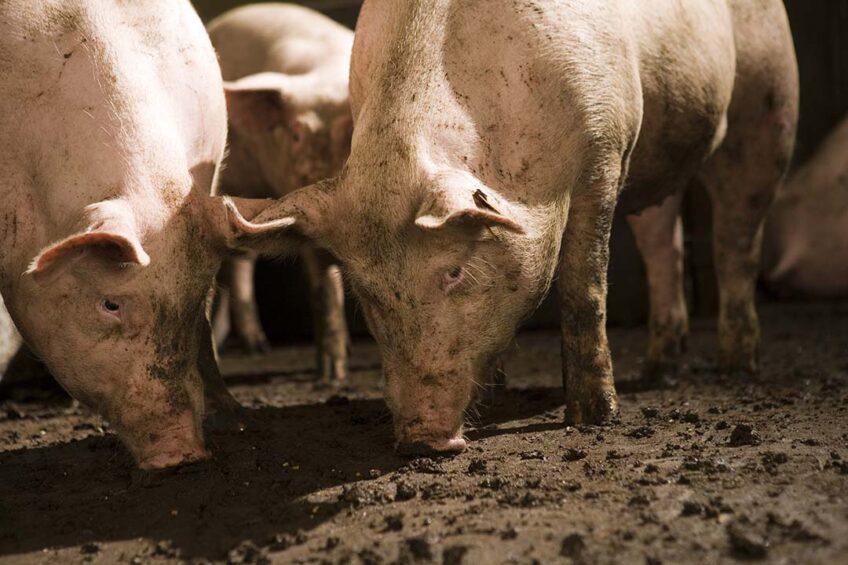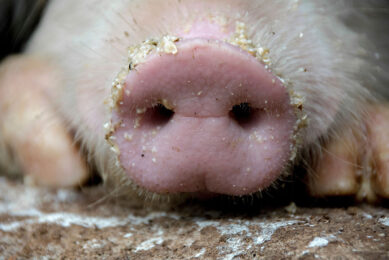Reducing Salmonella in pig production systems

Salmonella is one of key global causes of diarrhoeal diseases in pigs. Outbreaks resulting in human foodborne Salmonella illnesses associated with pork have been consistently reported on an annual basis, identifying pork as a vehicle for salmonellosis. Trying to get the bacteria under control is vital, but how to get there?
In the United States, more than 50% of pig operations are faecal positive for Salmonella. Therefore, preventing salmonellosis in pigs is important for pig health and welfare, economic productivity, food safety and public health. Controlling Salmonella on pig farms is complex at each production stage. Therefore, multiple intervention areas are required to decrease Salmonella on pig farms. This article discusses vaccination and biosecurity as potential methods to reduce Salmonella in swine production systems.
Salmonella transmission in pigs
Salmonella can be spread via horizontal transmission mechanisms throughout the pig production chain, including the feed, water sources, transportation vehicles, the lairage setting, surfaces in the processing plant. Vectors, such as insects, rodents, migratory birds and humans, can also be a route of transmission.
In addition, Salmonella can be spread via vertical transmission from sow to piglet, as well as via circular transmission (both horizontal and vertical transmission), creating an everlasting cycle of contamination on the farm.
Salmonella can revive during stressful events in animal production, such as farrowing, transportation and lairage due to its commensal-like state in pigs
Asymptomatic carriers
Due to the high frequency of asymptomatic carriers of Salmonella, the infection is unknowingly transmitted to other pigs in the same pen, thus contaminating the environment through manure handling, and infecting processing plants and meat products during processing. Furthermore, Salmonella can revive during stressful events in animal production, such as farrowing, transportation and lairage due to its commensal-like state in pigs. In addition, weaning is a stress-associated phase accompanied by sudden changes in diet, alterations in gut microbiota, and weaning of maternal antibodies which increases the susceptibility of Salmonella-free pigs to infection by Salmonella shedders.
Vaccination against Salmonella in pigs
Salmonella vaccination programmes aim to decrease the load of Salmonella entering the processing plants, to reduce environmental contamination and to improve food safety and public health. Vaccination stimulates the immune response and decreases subclinical and clinical Salmonella infections in pigs.
Live attenuated Salmonella vaccines induce both antibody and cell-mediated immunity, provide serovar or serogroup cross-protection and avoid interference with herd surveillance programmes for Salmonella. This type of vaccine is highly effective; however, reaching the delicate balance between over-attenuation, in which the host immune system is not sufficiently stimulated for infection protection, and under-attenuation, in which the vaccine strain causes clinical manifestations upon vaccination, is challenging.
Inactivated vaccines
Inactivated vaccines relieve the concern of under-attenuation of the vaccine strain, and the potential virulence regaining of the vaccine strain. Although inactivated vaccines may poorly induce immune response, advances in adjuvants and antigen expression technologies have improved their immunogenicity.
Factors including pig age and production stage impact the choice of vaccination strategy. For example, sows are usually vaccinated before farrowing to increase passive immunity in suckling piglets, piglets are vaccinated before weaning to stimulate immunity against infection before passive immunity wanes, and grower pigs are vaccinated at the finishing stage to lower the load of Salmonella entering the processing plants. Furthermore, an outbreak or endemic carriage of a particular Salmonella serovar impacts the choice of vaccination strategy. In this case, the autogenous vaccines that are custom-made from the specific serovar identified on the farm are used.
External biosecurity measures
External biosecurity is defined as the procedures and practices that reduce the transmission of pathogens from sources outside the farm, including people, vehicles, transporting pigs and pest control. Pig farms receive lots of visitors and vehicles, including farm workers, veterinarians, repair workers, transports of feedstuffs and dead animals. People’s fomites or even the people themselves can spread Salmonella, as well. A combination of barrier measures and regulations limiting the entrance to the farm can lower the risk associated with visits.
Nothing should be allowed to cross from the dirty area to the clean area without being decontaminated
It is required to establish a clear delimitation of clean and dirty areas. Nothing should be allowed to cross from the dirty area to the clean area without being decontaminated. Clean areas are considered to be all pig-contact areas within the farm perimeter. Dirty areas are considered all areas outside of these clean areas. Vehicles delivering feedstuff, collecting dead animals or slurry that require some level of contact with the farm can be placed in the external perimeter of the farm. All people need to enter via a reception building with certain barriers established at entering the premises, such as showering, handwashing, changing clothes, and observing at least a 24–48 hour gap between the current visit and a previous visit to another farm.
Best approach to minimise risks of infection during transport
The best approach to minimise the risks of infection while transporting pigs is to build a loading/unloading dock with a dirty area outside the farm where trucks may park. The dirty area leads to a narrow managing corridor with a gate and the area from this gate inwards should be considered the clean area. Rodents and birds can be carriers of some Salmonella serovars. Therefore, it is recommended to place bird-proof nets on windows and keep the doors closed to avoid the entry and nesting of birds. Furthermore, silos and feed tanks need to be closed to prevent access by rodents and birds.
Internal biosecurity measures
Internal biosecurity is defined as the procedures and practices that reduce the probability of the spread of pathogens once the farm has been infected. An important part of internal biosecurity is to control the flow of animals to prevent mixing pigs from different age groups through the strict application of an all-in, all-out system complemented by cleaning and disinfecting the facilities before the arrival of new batches of animals. In addition, separating piglets from their mothers at an earlier age would prevent vertical salmonella transmission. Moreover, a work routine that follows the pig flow from younger to older ages within the farm needs to be established.
Concluding remarks
Vaccination with either live or inactivated vaccines would reduce Salmonella-positive cases in pig farming. In addition, internal and external biosecurity measures are implemented along the production chain to minimise the risk of introducing or spreading Salmonella within the farms. Further research is required to find sustainable biosecurity programmes and to address their continuous improvement on pig farms.
* References are available upon request.











